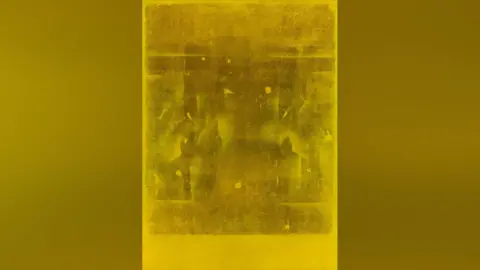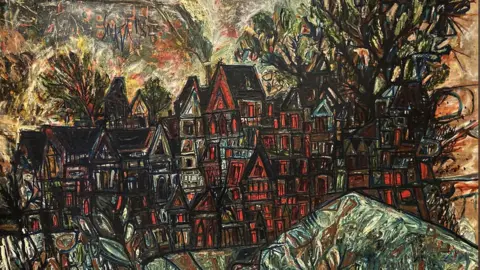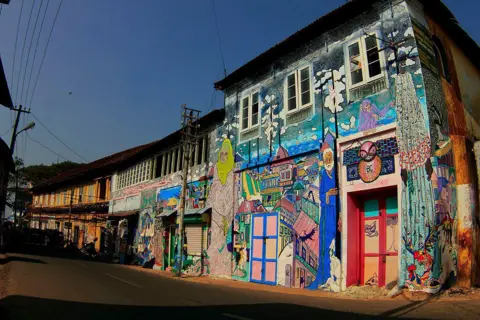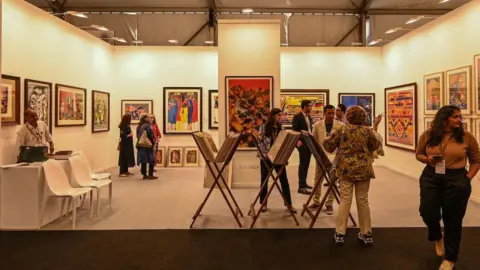Anahita SachdevBBC News, Delhi
 Saffronart
SaffronartA radiant golden canvas layered with subtle textures and faint shapes, exuding both energy and tranquillity.
This untitled 1971 painting by Vasudeo Santu Gaitonde headlined a record-breaking recent Saffronart auction in Delhi, which fetched $40.2m (£29.9m) – the highest-ever total for South Asian art. Gaitonde’s work alone sold for $7.57m, nearly three times its estimate, making it India’s second most expensive painting.
The bidding added momentum to an already strong auction season for Indian art.
Just days later, Sotheby’s sold artist Francis Newton Souza’s landscape, Houses in Hampstead, at a price marginally lower than Gaitonde’s piece, making it India’s third highest grossing painting. Earlier this year, the record for India’s most expensive painting was reset when MF Husain’s Untitled (Gram Yatra) fetched a staggering $13.8m.
Auctioneers and curators say India’s art market is witnessing an unprecedented boom, driven by a surge of art fairs, galleries, and exhibition spaces across cities and towns.
Industry insiders estimate that the market is worth $338m, up exponentially from $2m at the turn of the century, and will expand to $1.1bn by 2030.
 Sotheby’s
Sotheby’sDinesh Vazirani, a founder of Saffronart, believes this is a “point of massive inflection”.
Marking its 25th anniversary, Saffronart’s recent auction saw a packed room, spirited bidding, and a rare “white glove” result – every lot sold, with some attendees even “squabbling” over artworks, according to an attendee.
“When we started in 2000, people said we were crazy. Who’s going to buy art online?” Mr Vazirani said.
“Seeing the art market with so much strength almost validated that what we started as maybe foolish young people has become a very mature industry.”
The boom in Indian art – which dominates South Asia’s market – comes even as global art sales slump. The 2024 Art Basel and UBS report shows a 12% drop worldwide, the second yearly decline.
Mr Vazirani predicts the auction market could double last year’s earnings, driven by rising wealth in India and among the diaspora.
Millionaire households have nearly doubled in four years. As the rich pour money into their luxurious lifestyle, art has become both a status symbol and an investment.
For these groups, art is a generational asset that can also be enjoyed, Mr Vazirani argues.
“They understand that you can’t buy it and trade in it. But if you hold it for long periods of time, the appreciation is quite dramatic.”
Recent tax cuts slashing goods and services tax (GST) on art from 12% to 5% have also helped boost the market.
While global buyers dominate, much of the demand abroad comes from diaspora collectors seeking “a slice of their heritage”, said Manjari Sihare-Sutin, co-head of Sotheby’s Indian and South Asian Art department. Its recent auction, which sold the Souza painting, was another “white glove” sale, earning $25.5m – the department’s highest total in 30 years.
“I think art has become an important conduit for both local collectors and Indian diaspora outside of India to reconnect with their roots,” Ms Sihare-Sutin said.
 Getty
GettyThese trends have attracted new buyers: a third of Sotheby’s last-month bidders were first-timers with them, while Saffronart reports 25–30% of its buyers are recent entrants.
While top sales often feature established modernists like Husain, Souza, Gaitonde, and Raza, auctioneers say rising top prices lift demand and values for previously overlooked artists as well.
Unlike the brief speculative boom of the early 2000s, which collapsed in 2008, insiders say the current surge in the Indian art market feels more sustainable, going beyond galleries and auctions.
Curator Ina Puri notes a resurgence in India’s art scene, driven by growing recognition of Indian artists and increased investment in spaces for public engagement.
“I feel that Indian art has made a comeback,” Ms Puri said.
“Across the country, there are new institutions, museums and spaces coming up to showcase art.”
Government funding for the arts has long lagged behind other priorities, leaving the private sector to lead. A notable example is Kiran Nadar Museum of Art’s new Delhi building, set to open in 2026, spanning 100,000 sq m and showcasing both visual and performance art.
Other examples: Hampi Art Labs in Karnataka offers exhibitions and artist residencies; Art Mumbai fair’s third edition in November expects 40,000 visitors; and Renault’s planned Chennai design centre will merge technology with artistic collaboration.
These join established events like the India Art Fair in Delhi and Kochi-Muziris Biennale in Kerala, which draw record crowds annually.
Galleries are increasingly showcasing indigenous and marginalised art, Ms Puri said, though more support is needed for students and emerging artists.
 AFP via Getty Images
AFP via Getty ImagesDelhi-based non-profit Khoj, founded in 1997, tries to fill this gap by supporting emerging artists through programs and residencies. Director Pooja Sood notes growing participation from smaller towns often overlooked by the art world.
“They’re trying to build their own thing,” she said. “It’s fantastic”.
Rising interest in South Asian art boosts the ecosystem, but record-breaking sales of established artists don’t directly aid newcomers – ground-up support remains essential.
Ms Sood stresses that Khoj operates outside the commercial art world, offering young and mid-career artists a space to explore, experiment, and “even fail if they have to”.
“I feel the more mad, crazy, experimental art happens in very small pockets, and that’s what we’re always trying to build.”



